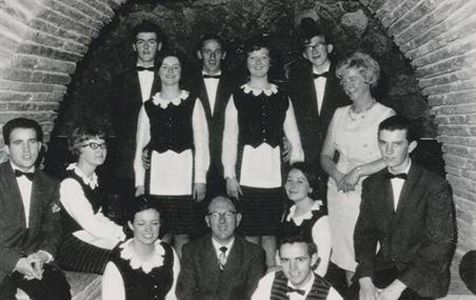THE RAILWAY HOTEL

by Tom Kenny
This ancient site on the southern end of what we now know as Eyre Square was occupied by a Knights Templars convent in the 13th century. By the 17th century Robert Martin had a large house on the site, but this was taken from him by the Cromwellians and given to Edward Eyre. The Eyre family held on to the property and on May 12th, 1712, Edward Eyre, son of the above, presented the land in front of his house to the Corporation as a place of recreation for the people of Galway. In 1827, a man named Atkinson built houses at this end of the Square and by 1845, the site was occupied by a block of tenements owned by Fr. Peter Daly.
Construction had just started on a railway line from Dublin to Galway with the intention of having the terminus at Renmore. Fr. Daly convinced the Railway Company to build a bridge across Lough Athalia and bring the line right into the city. In order to facilitate this, he evicted all of his tenants from the tenements and then complained to the authorities that these people had no place to live. The tenements were demolished leaving the site vacant for development.
The hotel was designed by the Railway Company’s architect, John Skipton Mulvany and the building contract was awarded to William Dargan. He used limestone ashlar in the construction and included a cornice over the heavily rusticated ground floor. The façade consisted of thirteen bays with a three-bay break-front at the entrance and two advanced bays at either end of the building. Early descriptions of the hotel mention only three storeys, a fourth must have been added shortly after it opened, as can be seen from early photographs.
There was huge public interest as construction got under way and it must have made a remarkable impact on the town having the hotel and the railway operating within such a short space of time. A low plinth wall was built across the front of the hotel and railings were later erected on this.
The hotel opened for business on August 16th, 1852. It had ‘every modern convenience, exceptional accommodation and guests were absorbed into superb surroundings at moderate cost’. Described as ‘the principal ornament of our ancient town', it had 69 bedrooms, a saloon 50ft x 24ft, 4 dining rooms, 2 spacious coffee rooms measuring 36ft by 22ft, classic corridors and galleries with a grand staircase in the centre of the main hall. There were 100 gas lamps fitted throughout the building with the fuel supplied by the Galway Gas Company.

According to a contemporary report “This magnificent hotel is unsurpassed, either in external appearance or internal arrangements, by any similar establishment in the kingdom….. it is provided with all the requirements needed for comfort as well as for luxury. Thorough ventilation having been the main object with the architect, corridors run the entire length of the building, and are lighted from domes in the roof, thus ensuring at all times a current of pure air, a want so frequently felt in similar establishments. On each floor are hot, cold and shower baths, always ready. As the building forms the front of the railway terminus, visitors enter the hotel from the platform”.
The hotel was now up and running and doing business.
It has undergone many name changes since, it was known originally as The Railway Hotel, then The Great Southern, it was briefly referred to as The Meyrick and for the last few years it has been called The Hardiman Hotel. The building has been added to on a number of occasions and there have been many internal changes ..... has there ever been a hotel bar that has changed around so many times? It has hosted presidents, politicians, personalities, sportspeople, film stars, people like Charles Stewart Parnell, Michael Davitt, William Wilde, King Edward VII, William Butler Yeats, Charles LIndbergh, Alcock and Browne, Walt Disney, Paul McCartney, Bing Crosby, the list goes on and on. It has catered for visitors from all over the world and hosted thousands of events such as the Oyster Festival, the Hunt Ball etc.
The colourful history of the hotel has now been thoroughly researched and published in book form by local historian, William Henry under the title "The Hardiman, An Amazing Story". It is an amazing story and is well told and profusely illustrated, a terrific addition to the social history of Galway over the last 170 years, and is available from good bookshops at 25 euro.
Our images today are taken from the book, the drawing was probably the earliest illustration ever done of the hotel, it was an advertisement published c.1852. The photograph is of the staff of the Cois Fharraige section and dates from 1964/65. They are, seated, Paddy Gannon, Bríd Ní Ghallchóir, Maureen Ní Dhonncha, John Connaughton, Pádraig Mac Donncha, Áine O'Malley, Tommy Heffernan. Standing are James Fleming, Peggy Folan, Pat Walsh, Nuala Ní Gallchóir, John Ryan and Celia Ryan.
.png)